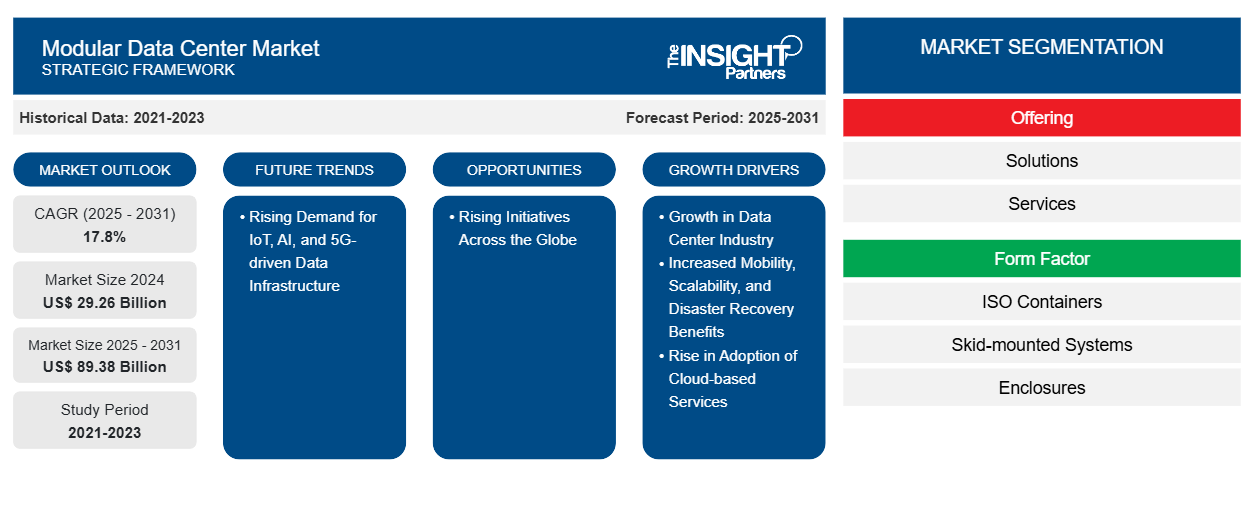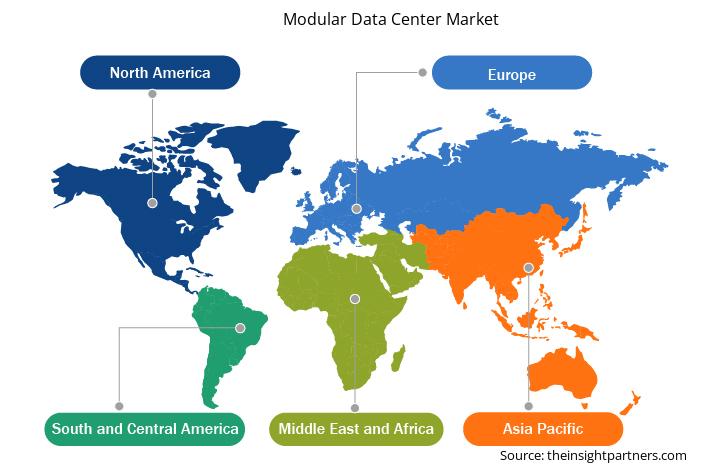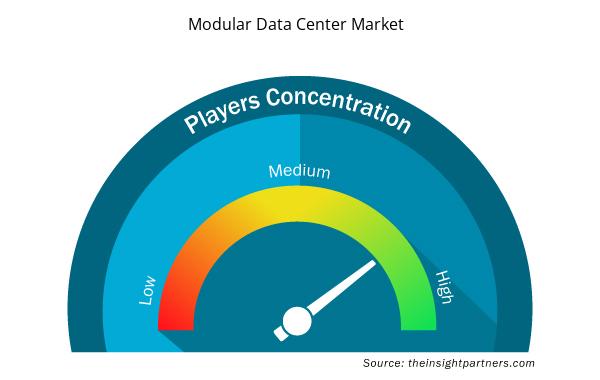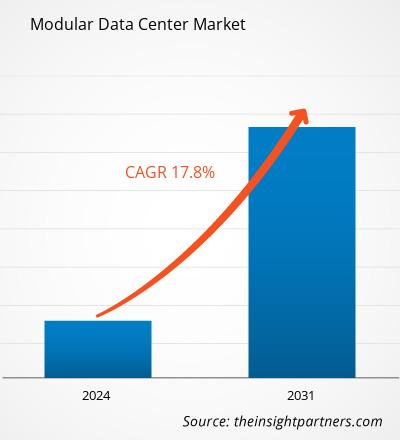Der Markt für modulare Rechenzentren wurde im Jahr 2024 auf 29,26 Milliarden US-Dollar geschätzt und soll bis 2031 89,38 Milliarden US-Dollar erreichen. Für den Zeitraum 2025–2031 wird eine durchschnittliche jährliche Wachstumsrate (CAGR) von 17,8 % erwartet. Die steigende Nachfrage nach IoT-, KI- und 5G-basierter Dateninfrastruktur dürfte im Prognosezeitraum ein wichtiger Markttrend sein.
Marktanalyse für modulare Rechenzentren
Das globale Wachstum des Marktes für modulare Rechenzentren wird durch die Vorteile von Mobilität, Skalierbarkeit und Notfallwiederherstellung vorangetrieben. Diese Innovationen bieten schnelle und flexible Lösungen, die Unternehmen die Bereitstellung von IT-Systemen ermöglichen. Unternehmen benötigen Sicherheit hinsichtlich der Betriebskontinuität und der Fähigkeit, sich von potenziellen Störungen zu erholen. Der Markt bietet verschiedene Lösungen mit robusten Strukturen, die sich leicht verlagern oder erweitern lassen, um den spezifischen Anforderungen eines Unternehmens gerecht zu werden. Diese Flexibilität ist entscheidend für die Aufrechterhaltung der Geschäftskontinuität bei Katastrophen oder anderen unvorhergesehenen Ereignissen und gewährleistet den Schutz ihrer Daten und Anwendungen.
Marktübersicht für modulare Rechenzentren
Ein modulares Rechenzentrum bietet einen skalierbaren und flexiblen Ansatz für die Verwaltung der IT-Infrastruktur. Einzelne Komponenten oder Module sind vorgefertigte Einheiten, die bei Bedarf zusammengebaut und erweitert werden können. Im Gegensatz zu herkömmlichen Rechenzentren, die große, zentralisierte Bauprojekte erfordern, bestehen modulare Rechenzentren aus standardisierten Einheiten, die schnell bereitgestellt und angepasst werden können. Diese Modularität ermöglicht es Unternehmen, ihre Kapazitäten im Laufe der Zeit ohne nennenswerte Unterbrechungen oder hohe Vorabinvestitionen zu erweitern. Modulare Rechenzentren bieten mehrere entscheidende Vorteile. Sie sind skalierbar und ermöglichen es Unternehmen, ihre Datenverarbeitungskapazität entsprechend ihrem wachsenden Bedarf zu erhöhen. Das macht sie besonders wertvoll für Unternehmen mit schnellem Wachstum oder schwankender Nachfrage. Der modulare Aufbau ermöglicht zudem eine schrittweise Erweiterung der IT-Infrastruktur, minimiert unnötige Kosten und verhindert eine Überbereitstellung. Die Nachfrage nach flexiblen und portablen Lösungen steigt, da Unternehmen bestrebt sind, sich an die sich entwickelnden Marktanforderungen anzupassen. Modulare Rechenzentren ermöglichen Unternehmen eine bedarfsgerechte Erweiterung ihrer Infrastruktur mit weniger Ausfallzeiten im Vergleich zu herkömmlichen Rechenzentren. Diese Flexibilität ist besonders vorteilhaft für Branchen wie den Einzelhandel mit schwankender Nachfrage oder für Unternehmen, die neue Märkte erschließen. Da Flexibilität und schnelle Reaktion für den Geschäftserfolg immer wichtiger werden, werden modulare Rechenzentren zunehmend als wertvolle Vermögenswerte angesehen, die Unternehmen dabei helfen, Herausforderungen effektiv zu bewältigen und ihre Betriebsabläufe zu optimieren.
Passen Sie diesen Bericht Ihren Anforderungen an
Sie erhalten kostenlos Anpassungen an jedem Bericht, einschließlich Teilen dieses Berichts oder einer Analyse auf Länderebene, eines Excel-Datenpakets sowie tolle Angebote und Rabatte für Start-ups und Universitäten
Markt für modulare Rechenzentren:

- Informieren Sie sich über die wichtigsten Markttrends in diesem Bericht.Dieses KOSTENLOSE Beispiel umfasst eine Datenanalyse, die von Markttrends bis hin zu Schätzungen und Prognosen reicht.
Markttreiber und Chancen für modulare Rechenzentren
Wachstum in der Rechenzentrumsbranche
Die Rechenzentrumsbranche hat in den letzten zehn Jahren ein starkes Wachstum erlebt, das durch den zunehmenden Datenverbrauch, die Nutzung der Cloud und die Verbreitung von IoT-Geräten angetrieben wurde. Laut JLL erlebt die Rechenzentrumsbranche im September 2024 eine überwältigende Nachfrage seitens der Nutzer. Bis Mitte 2024 hat die verfügbare Kapazität an Colocation-Rechenzentren in den USA 12 GW erreicht und sich seit 2020 verdoppelt, mit einer durchschnittlichen jährlichen Wachstumsrate von 21 %. Nord-Virginia ist weiterhin der größte Markt und macht fast die Hälfte des Kapazitätsausbaus seit 2020 aus. Damit übertrifft es andere Regionen bei weitem. Die Märkte im Süden und Westen der USA verzeichnen jedoch ein schnelleres Wachstum. Da Organisationen und Unternehmen ihre digitale Infrastruktur weiter ausbauen, ist der Bedarf an effizienter und zuverlässiger Verwaltung komplexer IT-Systeme gestiegen. Dies hat zu einer wachsenden Nachfrage nach modularen Rechenzentren geführt, die eine zentrale Rolle für die reibungslose Verwaltung des Rechenzentrumsbetriebs spielen.
Steigende Nutzung Cloud-basierter Dienste
Regierungen und große Unternehmen priorisieren die Implementierung fortschrittlicher Cloud -Lösungen und -Anwendungen. Führende Branchenakteure konzentrieren sich auf die Entwicklung hochmoderner modularer Rechenzentren, die mit immersiven Technologien ausgestattet sind, um riesige Datenmengen zu verwalten. So stellte Vertiv, ein weltweit führendes Unternehmen für kritische digitale Infrastrukturen und Kontinuitätslösungen, im Juli 2025 den Vertiv MegaMod CoolChip vor, eine vorgefertigte modulare (PFM) Rechenzentrumslösung mit Flüssigkeitskühlung, die effizientes und zuverlässiges KI- Computing unterstützen soll . Diese Lösung kann an Plattformen führender KI-Computing-Anbieter angepasst und entsprechend den Kundenanforderungen skaliert werden. Durch die Kombination des hochwertigen, prozesseffizienten Ansatzes der Offsite-Fertigung mit fortschrittlichen KI-fähigen Technologien kann der MegaMod CoolChip die Bereitstellungszeit für KI-kritische digitale Infrastrukturen um bis zu 50 % reduzieren.
Segmentierungsanalyse des Marktberichts für modulare Rechenzentren
Wichtige Segmente, die zur Ableitung der Marktanalyse für modulare Rechenzentren beigetragen haben, sind Angebot, Lösungen, Formfaktor, Organisationsgröße und Branche.
- Angebotsseitig ist der Markt in Lösungen und Dienstleistungen unterteilt.
- Basierend auf Lösungen ist der Markt in vorgefertigte Module und Komplettlösungen segmentiert.
- Hinsichtlich des Formfaktors ist der Markt in ISO-Container, auf einem Schlitten montierte Systeme und Gehäuse unterteilt.
- Auf Grundlage der Unternehmensgröße wird der Markt in KMU und Großunternehmen unterteilt.
- Nach Branchen ist der Markt in IT und Telekommunikation, BFSI, Regierung, Gesundheitswesen, Fertigung, Medien und Unterhaltung und Sonstige unterteilt.
Marktanteilsanalyse für modulare Rechenzentren nach geografischer Lage
- Der Markt für modulare Rechenzentren ist in fünf Hauptregionen unterteilt: Nordamerika, Europa, Asien-Pazifik (APAC), Naher Osten und Afrika (MEA) sowie Süd- und Mittelamerika. Nordamerika dominierte den Markt im Jahr 2024, gefolgt von Europa und dem Asien-Pazifik-Raum.
- Der Markt für modulare Rechenzentren in Nordamerika ist in die USA, Kanada und Mexiko unterteilt. Die schnelle Verbreitung datenintensiver Anwendungen und des Cloud-Computings hat zu einem erheblichen Anstieg der Anzahl von Rechenzentren in der Region geführt. Laut der CBRE North America Data Center Trend Analysis 2024 befinden sich die sieben größten Rechenzentrumsmärkte Nordamerikas in den USA, nämlich in Nord-Virginia, Dallas/Fort Worth, Silicon Valley, Chicago, Phoenix, der New York Tri-State Area und Atlanta. Die schnelle Verbreitung von Cloud-Computing, IoT, KI und 5G-Technologien treibt die Nachfrage nach skalierbaren und effizienten Rechenzentren in Nordamerika an. Diese Technologien erfordern eine robuste, flexible und zuverlässige Infrastruktur, weshalb modulare Rechenzentren eine ideale Lösung darstellen. Modulare Rechenzentren bieten die nötige Skalierbarkeit, um die wachsenden Datenmengen zu bewältigen, und ermöglichen es Unternehmen, ihre Infrastruktur schnell zu skalieren, um sich an veränderte Anforderungen anzupassen.
- Der Bedarf an latenzarmer, lokaler Datenverarbeitung wird immer wichtiger, insbesondere mit dem Aufkommen von IoT- und Echtzeit-Datenanwendungen. Modulare Rechenzentren bieten eine Lösung: Unternehmen können kleinere, geografisch verteilte Einheiten einsetzen, die die Latenz reduzieren und die Leistung verbessern. Dies ist besonders wichtig in Branchen wie der Automobilindustrie, dem Gesundheitswesen und der Fertigung, in denen Echtzeit-Datenverarbeitung für die betriebliche Effizienz entscheidend ist. Ebenso ist der wachsende Trend zum Edge Computing in Nordamerika ein wichtiger Treiber für die Einführung modularer Rechenzentren. Da Unternehmen nach mehr Rechenleistung näher an der Datenquelle streben, bieten modulare Rechenzentren die Flexibilität und die schnellen Bereitstellungsmöglichkeiten, die für Edge-Computing-Anwendungen erforderlich sind.
- Vertiv Group, Schneider Electric und Emerson sind einige der führenden Unternehmen auf dem europäischen Markt für modulare Rechenzentren. Diese Anbieter ergreifen verschiedene Initiativen zur Entwicklung modularer Rechenzentren. Im November 2024 hat Schneider Electric, der Marktführer für die digitale Transformation von Energiemanagement und Automatisierung, die Fertigungs- und Produktionskapazität seiner Fabrik für vorgefertigte Rechenzentren in Barcelona deutlich von 7.000 m² auf 12.000 m² erhöht, um der gestiegenen Kundennachfrage nach vorgefertigten Rechenzentrumslösungen für hohe Rechenlasten gerecht zu werden. Die Fabrik und das große Logistikzentrum in Sant Boi de Llobregat, Barcelona – einem der wichtigsten Standorte in Europa für Design, Produktion und Integration des EcoStruxure Modular Data Centre-Portfolios von Schneider Electric – bieten zusätzliche 5.000 m² dedizierte Produktionsfläche und erfüllen so die gestiegenen Kundenanforderungen nach schnellen Markteinführungen, Vorhersehbarkeit und belastbaren Rechenzentrumslösungen.
Regionale Einblicke in den Markt für modulare Rechenzentren
Die Analysten von Insight Partners haben die regionalen Trends und Faktoren, die den Markt für modulare Rechenzentren im Prognosezeitraum beeinflussen, ausführlich erläutert. In diesem Abschnitt werden auch die Marktsegmente und die geografische Lage modularer Rechenzentren in Nordamerika, Europa, Asien-Pazifik, dem Nahen Osten und Afrika sowie Süd- und Mittelamerika erörtert.

- Erhalten Sie regionale Daten zum Markt für modulare Rechenzentren
Umfang des Marktberichts über modulare Rechenzentren
| Berichtsattribut | Details |
|---|---|
| Marktgröße im Jahr 2024 | 29,26 Milliarden US-Dollar |
| Marktgröße bis 2031 | 89,38 Milliarden US-Dollar |
| Globale CAGR (2025 – 2031) | 17,8 % |
| Historische Daten | 2021-2023 |
| Prognosezeitraum | 2025–2031 |
| Abgedeckte Segmente | Durch das Angebot
|
| Abgedeckte Regionen und Länder | Nordamerika
|
| Marktführer und wichtige Unternehmensprofile |
|
Marktdichte modularer Rechenzentren: Auswirkungen auf die Geschäftsdynamik
Der Markt für modulare Rechenzentren wächst rasant. Die steigende Endverbrauchernachfrage ist auf Faktoren wie veränderte Verbraucherpräferenzen, technologische Fortschritte und ein stärkeres Bewusstsein für die Produktvorteile zurückzuführen. Mit der steigenden Nachfrage erweitern Unternehmen ihr Angebot, entwickeln Innovationen, um den Verbraucherbedürfnissen gerecht zu werden, und nutzen neue Trends, was das Marktwachstum weiter ankurbelt.
Die Marktteilnehmerdichte beschreibt die Verteilung der in einem bestimmten Markt oder einer bestimmten Branche tätigen Unternehmen. Sie gibt an, wie viele Wettbewerber (Marktteilnehmer) in einem bestimmten Marktraum im Verhältnis zu dessen Größe oder Gesamtmarktwert präsent sind.
Die wichtigsten Unternehmen auf dem Markt für modulare Rechenzentren sind:
- Schneider Electric SE
- PCX Holding LLC
- Huawei Digital Power Technologies Co Ltd
- Delta Electronics Inc
- Rittal GmbH & Co KG
- Eaton Corp Plc
Haftungsausschluss : Die oben aufgeführten Unternehmen sind nicht in einer bestimmten Reihenfolge aufgeführt.

- Überblick über die wichtigsten Akteure auf dem Markt für modulare Rechenzentren
Neuigkeiten und aktuelle Entwicklungen zum Markt für modulare Rechenzentren
Der Markt für modulare Rechenzentren wird durch die Erhebung qualitativer und quantitativer Daten aus Primär- und Sekundärforschung bewertet. Dazu zählen wichtige Unternehmenspublikationen, Verbandsdaten und Datenbanken. Nachfolgend sind einige Entwicklungen im Markt für modulare Rechenzentren aufgeführt:
- Eaton und CTS Nordics – ein Unternehmen, das Rechenzentren plant und baut – errichten in Oslo eine neue NordicEPOD-Anlage. Die hochmoderne Anlage von NordicEPOD produziert nun standardisierte Strommodule, sogenannte EPODs, die die Bauzeit von Rechenzentren um mehrere Wochen verkürzen.
(Quelle: Eaton, Pressemitteilung, 2025)
- Schneider Electric, der weltweit führende Anbieter im Bereich der digitalen Transformation von Energiemanagement und Automatisierung, hat in Red Oak, Texas, eine neue 105.000 Quadratmeter große Integrationsanlage eröffnet. In dieser soll eine vorgefertigte modulare Infrastruktur aufgebaut werden, um die wachsende Nachfrage nach neuen Rechenzentren in den gesamten USA zu decken.
(Quelle: Schneider Electric, Pressemitteilung, 2024)
Marktbericht zu modularen Rechenzentren: Umfang und Ergebnisse
Die „Marktgröße und Prognose für modulare Rechenzentren (2021–2031)“ bietet eine detaillierte Analyse des Marktes, die die unten genannten Bereiche abdeckt:
- Marktgröße und Prognose für modulare Rechenzentren auf globaler, regionaler und Länderebene für alle wichtigen Marktsegmente, die im Rahmen des Berichts abgedeckt sind
- Markttrends für modulare Rechenzentren sowie Marktdynamiken wie Treiber, Einschränkungen und wichtige Chancen
- Detaillierte PEST- und SWOT-Analyse
- Marktanalyse für modulare Rechenzentren mit wichtigen Markttrends, globalen und regionalen Rahmenbedingungen, wichtigen Akteuren, Vorschriften und aktuellen Marktentwicklungen
- Branchenlandschafts- und Wettbewerbsanalyse mit Marktkonzentration, Heatmap-Analyse, prominenten Akteuren und jüngsten Entwicklungen für den Markt für modulare Rechenzentren
- Detaillierte Firmenprofile
- Historische Analyse (2 Jahre), Basisjahr, Prognose (7 Jahre) mit CAGR
- PEST- und SWOT-Analyse
- Marktgröße Wert/Volumen – Global, Regional, Land
- Branche und Wettbewerbsumfeld
- Excel-Datensatz



Report Coverage
Revenue forecast, Company Analysis, Industry landscape, Growth factors, and Trends

Segment Covered
This text is related
to segments covered.

Regional Scope
North America, Europe, Asia Pacific, Middle East & Africa, South & Central America

Country Scope
This text is related
to country scope.
Häufig gestellte Fragen
The key players, holding majority shares, in modular data center market includes Huawei Technologies Co., Ltd., Dell Inc., Schneider Electric, Hewlett Packard Enterprise Development LP, and ABB Ltd.
The North America held the largest market share in 2024, followed by Europe.
The modular data center market was valued at US$ 29.25 billion in 2024 and is projected to reach US$ 89.37 billion by 2031; it is expected to grow at a CAGR of 17.8% during 2025–2031.
Growth in data center industry and increased mobility, scalability, and disaster recovery benefits, and rise in adoption of cloud-based services are the driving factors impacting the modular data center market.
Rising Demand for IoT, AI, and 5G-driven Data Infrastructure is the future trends of the modular data center market.
The modular data center market is expected to reach US$ 89.37 billion in the year 2031.
Trends and growth analysis reports related to Technology, Media and Telecommunications : READ MORE..
The List of Companies - Modular Data Center Market
- Schneider Electric SE
- PCX Holding LLC
- Huawei Digital Power Technologies Co Ltd
- Delta Electronics Inc
- Rittal GmbH & Co KG
- Eaton Corp Plc
- Dell Technologies Inc
- Vertiv Group Corp.
- Hewlett Packard Enterprise Development LP
- ABB Ltd
The Insight Partners performs research in 4 major stages: Data Collection & Secondary Research, Primary Research, Data Analysis and Data Triangulation & Final Review.
- Data Collection and Secondary Research:
As a market research and consulting firm operating from a decade, we have published and advised several client across the globe. First step for any study will start with an assessment of currently available data and insights from existing reports. Further, historical and current market information is collected from Investor Presentations, Annual Reports, SEC Filings, etc., and other information related to company’s performance and market positioning are gathered from Paid Databases (Factiva, Hoovers, and Reuters) and various other publications available in public domain.
Several associations trade associates, technical forums, institutes, societies and organization are accessed to gain technical as well as market related insights through their publications such as research papers, blogs and press releases related to the studies are referred to get cues about the market. Further, white papers, journals, magazines, and other news articles published in last 3 years are scrutinized and analyzed to understand the current market trends.
- Primary Research:
The primarily interview analysis comprise of data obtained from industry participants interview and answers to survey questions gathered by in-house primary team.
For primary research, interviews are conducted with industry experts/CEOs/Marketing Managers/VPs/Subject Matter Experts from both demand and supply side to get a 360-degree view of the market. The primary team conducts several interviews based on the complexity of the markets to understand the various market trends and dynamics which makes research more credible and precise.
A typical research interview fulfils the following functions:
- Provides first-hand information on the market size, market trends, growth trends, competitive landscape, and outlook
- Validates and strengthens in-house secondary research findings
- Develops the analysis team’s expertise and market understanding
Primary research involves email interactions and telephone interviews for each market, category, segment, and sub-segment across geographies. The participants who typically take part in such a process include, but are not limited to:
- Industry participants: VPs, business development managers, market intelligence managers and national sales managers
- Outside experts: Valuation experts, research analysts and key opinion leaders specializing in the electronics and semiconductor industry.
Below is the breakup of our primary respondents by company, designation, and region:

Once we receive the confirmation from primary research sources or primary respondents, we finalize the base year market estimation and forecast the data as per the macroeconomic and microeconomic factors assessed during data collection.
- Data Analysis:
Once data is validated through both secondary as well as primary respondents, we finalize the market estimations by hypothesis formulation and factor analysis at regional and country level.
- Macro-Economic Factor Analysis:
We analyse macroeconomic indicators such the gross domestic product (GDP), increase in the demand for goods and services across industries, technological advancement, regional economic growth, governmental policies, the influence of COVID-19, PEST analysis, and other aspects. This analysis aids in setting benchmarks for various nations/regions and approximating market splits. Additionally, the general trend of the aforementioned components aid in determining the market's development possibilities.
- Country Level Data:
Various factors that are especially aligned to the country are taken into account to determine the market size for a certain area and country, including the presence of vendors, such as headquarters and offices, the country's GDP, demand patterns, and industry growth. To comprehend the market dynamics for the nation, a number of growth variables, inhibitors, application areas, and current market trends are researched. The aforementioned elements aid in determining the country's overall market's growth potential.
- Company Profile:
The “Table of Contents” is formulated by listing and analyzing more than 25 - 30 companies operating in the market ecosystem across geographies. However, we profile only 10 companies as a standard practice in our syndicate reports. These 10 companies comprise leading, emerging, and regional players. Nonetheless, our analysis is not restricted to the 10 listed companies, we also analyze other companies present in the market to develop a holistic view and understand the prevailing trends. The “Company Profiles” section in the report covers key facts, business description, products & services, financial information, SWOT analysis, and key developments. The financial information presented is extracted from the annual reports and official documents of the publicly listed companies. Upon collecting the information for the sections of respective companies, we verify them via various primary sources and then compile the data in respective company profiles. The company level information helps us in deriving the base number as well as in forecasting the market size.
- Developing Base Number:
Aggregation of sales statistics (2020-2022) and macro-economic factor, and other secondary and primary research insights are utilized to arrive at base number and related market shares for 2022. The data gaps are identified in this step and relevant market data is analyzed, collected from paid primary interviews or databases. On finalizing the base year market size, forecasts are developed on the basis of macro-economic, industry and market growth factors and company level analysis.
- Data Triangulation and Final Review:
The market findings and base year market size calculations are validated from supply as well as demand side. Demand side validations are based on macro-economic factor analysis and benchmarks for respective regions and countries. In case of supply side validations, revenues of major companies are estimated (in case not available) based on industry benchmark, approximate number of employees, product portfolio, and primary interviews revenues are gathered. Further revenue from target product/service segment is assessed to avoid overshooting of market statistics. In case of heavy deviations between supply and demand side values, all thes steps are repeated to achieve synchronization.
We follow an iterative model, wherein we share our research findings with Subject Matter Experts (SME’s) and Key Opinion Leaders (KOLs) until consensus view of the market is not formulated – this model negates any drastic deviation in the opinions of experts. Only validated and universally acceptable research findings are quoted in our reports.
We have important check points that we use to validate our research findings – which we call – data triangulation, where we validate the information, we generate from secondary sources with primary interviews and then we re-validate with our internal data bases and Subject matter experts. This comprehensive model enables us to deliver high quality, reliable data in shortest possible time.

 Holen Sie sich ein kostenloses Muster für diesen Bericht
Holen Sie sich ein kostenloses Muster für diesen Bericht